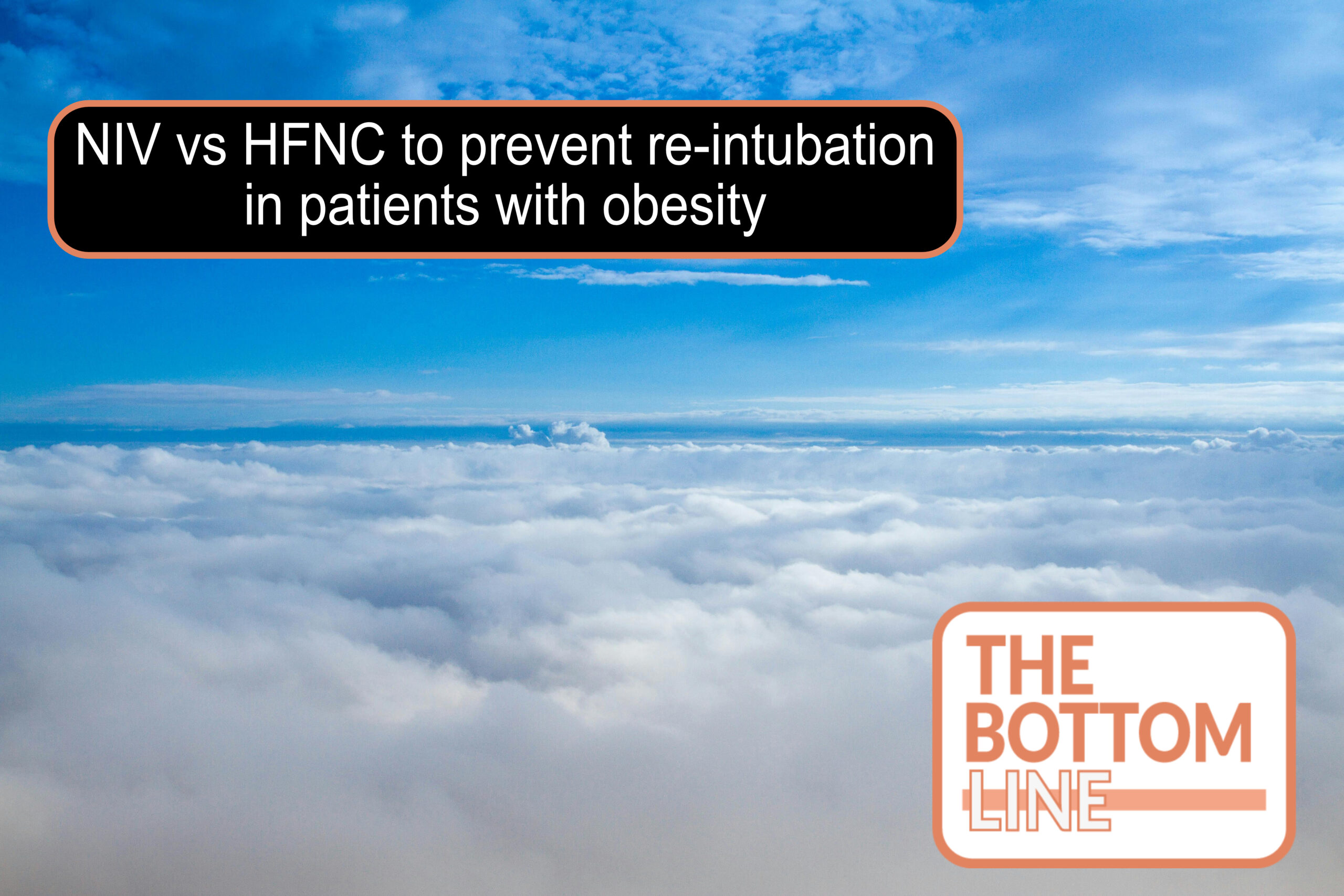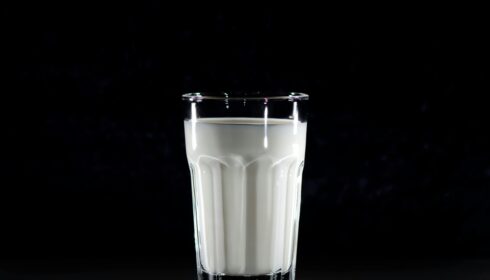NIV vs HFNC to prevent re-intubation in patients with obesity

Humidified Non-Invasive Ventilation versus High-Flow Therapy to Prevent Reintubation in Patients with Obesity
Hernández et al. AJRCCM 2025. DOI: 10.1164/rccm.202403-0523OC
Clinical Question
- In obese adult patients at intermediate risk for hypoxaemic extubation failure, does non-invasive ventilation (NIV) therapy with active humidification compared to use of high-flow nasal oxygen (HFNO or HFNC) reduce all-cause reintubation within 7 days after extubation?
Background
- One in eight people worldwide are considered to be obese
- Obesity is associated with impairment of normal respiratory physiology, including increased intra-abdominal and pleural pressures, atelectasis, obstructive sleep apnoea (OSA), and obesity hypoventilation syndrome (OHS)
- Post-extubation respiratory failure results in prolonged ICU and hospital stays, greater costs to the healthcare system, and increased patient mortality
- The optimal post-extubation respiratory support is currently unknown, however NIV is thought to be beneficial in obesity due to modifying the above impairments in respiratory function
- There are currently conflicting results in studies on weaning patients from mechanical ventilation, particularly in the setting of obesity
- Prior studies assessing respiratory support post-extubation or for hypoxaemic respiratory failure:
- Thille et al. 2024 – post-hoc analysis of three large-scale randomised controlled trials assessing the effect of prophylactic NIV after extubation in obese patients, all studies suggested that NIV is beneficial but not always statistically significant
- Thille et al. 2019 (HIGH-WEAN) – n=641, HFNC alternating with NIV reduced risk of reintubation at day 7 compared to HFNC alone
- De Jong et al. 2023 (EXTUB-OBESE) – n=981, NIV reduced relative risk of extubation failure compared to oxygen therapy, though most of the difference was due to patients in the oxygen therapy group switching to NIV
- Stéphan et al. 2015 (BIPOP) – n=830, high-flow nasal oxygen therapy was not inferior to BiPAP in patients with respiratory failure post cardiothoracic surgery
Design
- Multicentre randomised controlled superiority trial
- Recruitment:
- Screened for extubation readiness daily
- Recovery from precipitating illness
- Respiratory criteria – PF ratio >150, PEEP <8, pH >7.35
- Clinical criteria – no/low vasoactive drugs, HR <140, Hb >80, temp <38, no need for sedatives, presence of respiratory stimulus, appropriate spontaneous cough
- If meeting criteria for extubation readiness, then patients underwent a spontaneous breathing trial (SBT)
- Trial of spontaneous ventilation mode with pressure support of 7 cmH2O for 30 minutes
- SBT failure criteria included:
- Agitation, anxiety, depressed mental state, diaphoresis, cyanosis, increasing respiratory effort, facial signs of distress
- Respiratory – dyspnoea, PaO2 <60 or SpO2 <90% on FiO2 >0.5, PaCO2 >50 or increased >8 from baseline, pH <7.32 or decreased >0.07 from baseline, RR >35 or >50% from baseline
- Cardiovascular – HR >140 or increased >20% from baseline, SBP >180 or >20% from baseline, SBP <90, arrhythmias
- If SBT was tolerated, then patients were reconnected to the ventilator with the previous settings until planned for extubation
- Patients who passed the SBT were randomised (simple randomisation) to receive NIV or HFNC by means of a phone call to a call centre immediately before planned extubation after reconnection for rest
- Written informed consent was obtained from the patient’s relative on the day of the first SBT
- Screened for extubation readiness daily
- Defined clinical protocols were used for titration of NIV and HFNC
- Data was collected from bedside nursing charts, medical notes, pathology reports, electronic monitors, and interviews with relatives
- Continued until final discharge from hospital
- Analysed on intention-to-treat basis
- Sample size of 144 patients with 72 patients in each treatment arm
- Based on estimated absolute reduction in reintubation rate of 14% (from baseline of 17%) in order to achieve 80% power to detect difference with ɑ level of 5% and maximum tolerated patient loss rate of 10%
- Estimated reintubation rate in NIV group was therefore 3%
- Based on estimated absolute reduction in reintubation rate of 14% (from baseline of 17%) in order to achieve 80% power to detect difference with ɑ level of 5% and maximum tolerated patient loss rate of 10%
- Open-label and clinicians were unable to blinded due to the nature of the intervention
Setting
- Conducted in two ICUs in Spain
- Data collected from June 2020 to June 2021
Population
- Inclusion:
-
- Adult patients receiving mechanical ventilation for >24 hours and deemed ready for scheduled extubation according to tolerance of a spontaneous breathing trial, who have a BMI ≥30 kg/m2 and fulfil ≤2 of following criteria for high-risk for extubation failure:
- Age >65
- Heart failure as primary indication for mechanical ventilation
- Moderate to severe COPD
- APACHE II >12 points on extubation day
- Airway patency problems (including high risk of developing laryngeal oedema)
- Inability to deal with respiratory secretions (inadequate cough reflex or suctioning >2 times within 8 hours before extubation)
- Difficult or prolonged weaning
- 2 or more comorbidities (Charlson Comorbidity Index)
- Prolonged (>7 days) mechanical ventilation
- Only the first extubation episode was assessed
- Adult patients receiving mechanical ventilation for >24 hours and deemed ready for scheduled extubation according to tolerance of a spontaneous breathing trial, who have a BMI ≥30 kg/m2 and fulfil ≤2 of following criteria for high-risk for extubation failure:
-
- Exclusion:
-
- Age <18 years
- Pregnancy
- Do-not-resuscitate orders
- Tracheostomy prior to extubation
- Accidental extubation or self-extubation
- Hypercapnoea (PaCO2) >45mmHg at end of spontaneous breathing trial
-
- 2,356 patients assessed for eligibility –> 634 eligible –> 144 randomised
- 72 patients randomised to receive NIV and 72 patients randomised to receive HFNC
- There were some imbalances in patient characteristics, some of which favoured the NIV group and some of which favoured the HFNC group in terms of reintubation risk
- Comparing baseline characteristics of NIV vs. HFNC group:
- Median age: 62 vs. 60 years
- Women: 33% vs. 32%
- Median APACHE II score: 16.9 vs. 15.9
- Median length (days) of MV before extubation: 6 vs. 3
- BMI: 33 vs. 33
- Comorbidities:
- Heart disease 19% vs. 17 %
- COPD 10% vs. 3%
- High-risk factors for reintubation:
- Age >65: 32% vs. 28%
- Heart failure as primary indication for MV: 4% vs. 1%
- COPD: 7% vs. 3%
- APACHE II score >12 on extubation day: 8% vs. 3%
- Airway patency problems: 6% vs. 25%
- Inability to deal with respiratory secretions: 7% vs. 17%
- Difficult or prolonged weaning: 19% vs. 15%
- Two or more comorbidities: 45% vs. 60%
- Prolonged MV (>7 days): 32% vs. 25%
- Median number of high-risk factors: 3 vs. 3
- Diagnosis at admission:
- Respiratory primary failure: 71% vs. 36%
- COVID-19: 44% vs. 24%
- Haemodynamic failure: 39% vs. 35%
- Neurologic failure: 40% vs. 53%
- Surgical: 22% vs. 33%
Intervention
- NIV with active humidification for 48 hours post extubation, then changed to conventional oxygen therapy
- Started immediately after extubation
- Continuously delivered by bilevel positive airway pressure through size-fitted face mask
- Pressure support and positive end-expiratory pressure were adjusted to target RR 26 and adequate gas exchange based on SpO2 and arterial blood gases
- HFNC as alternative therapy was not allowed
- Sedatives to increase tolerance were not allowed
- Median IPAP 4 cm H2O, Median EPAP 8 cm H2O (Table E3)
Control
- HFNC for 48 hours post extubation, then changed to conventional oxygen therapy
- Started immediately after extubation
- Flow initially set at 10L/min then rapidly titrated upward in 5 L/min increments until patients experienced discomfort or up to 60L/min
- NIV as rescue therapy not allowed
- Median flow 60L/min
Management common to both groups
- Both groups were treated by the same medical, nursing, and respiratory therapy staff
- Both groups received similar medical management
- Details were not specified in the article or data supplement
Outcome
- Primary outcome:
- All-cause reintubation within 7 days after extubation:
- There was no significant difference in reintubation rates between the NIV and HFNC groups
- 17 patients (23.6%) in NIV group vs. 24 patients (33.3%) in HFNC group required reintubation
- Absolute risk difference 9.7% (95% CI -4.9 to 24.4)
- When adjusted for risk factors related to increased risk for extubation failure in patients with obesity, no significant benefit with NIV was observed (OR 0.71, 95% CI 0.32-1.58)
- Secondary outcomes:
- No significant difference in
- Post-extubation respiratory failure
- Ventilator-associated pneumonia
- Hospital LOS
- ICU and hospital mortality
- Time to reintubation
- Significantly greater in NIV group:
- ICU LOS
- Median 11 days in NIV group vs. 6.5 days in HFNC group (p=0.02)
- Intolerance to therapy
- 15% in NIV group vs. 4% in HFNC group (p=0.049)
- ICU LOS
- No significant difference in
- Post Hoc Bayesian Analysis:
- suggested high probability of benefit in NIV reducing reintubation compared to HFNC:
- Data-driven prior – RR 0.65 (95% CrI 0.44-0.96), posterior probability of RR <1 = 0.99
- Minimally informative prior – RR 0.70 (95% CrI 0.37-1.30), posterior probability of RR <1 = 0.87
- suggested high probability of benefit in NIV reducing reintubation compared to HFNC:
Authors’ Conclusions
- Among obese adult patients with intermediate risk of extubation failure, treatment with NIV did not significantly reduce the risk of reintubation within 7 days compared to HFNC
Strengths
- Allocation concealment via phone call to a call centre
- Assessed the reintubation rate at 7 days compared to many previous studies that assessed reintubation rate at 3 days
- Important given that morbidity and mortality has historically been highest when reintubation is required at 72-96 hours post extubation, and also that approximately ~25% had a time to reintubation > 72 hours in NIV group based on median time to reintubation was 52 (IQR 27 – 74) hours
- Detailed clinical protocol for starting, titrating, and modifying NIV and HFNC post extubation
- Increases ability of this study to be replicated in other settings
- High adherence to therapy in first 48 hours
- Interventions are easy to implement in all centres where the equipment is available
- Complete follow up with no crossover between NIV and HFNC groups
- No evident conflicts of interest including financial support
Weaknesses
- The study was conducted in two ICUs in Spain which may not be representative of all places of practice
- Median PEEP of 8cm H20 in NIV group – given physiological rationale of PEEP in this context, could higher levels of PEEP improve outcomes, or potentially lead to worse tolerance?
- Included a large number of patients with COVID-19 at admission (49 out of 144)
- Results might become less applicable to the general ICU population as rates of respiratory failure secondary to COVID-19 decline
- Open-label and unable to be blinded due to nature of intervention
- Increases risk of bias as nursing, medical, and respiratory therapy staff are aware of which treatment arm patients are assigned to which could impact clinical decision making for reintubation
- Will be an innate problem with all studies investigating similar interventions
- Imbalance in certain baseline characteristics between groups:
- Contributed to by small sample size and simple randomisation of groups
- NIV group had greater proportion of patients with longer mechanical ventilation, COPD, COVID-19, and primary respiratory failure
- HFNC group had greater proportion of patients with airway patency problems, neurologic failure, trauma, and surgical pathologies
- Absolute risk reduction of 14% used in power calculation seems overly optimistic
- Based on previous studies (including those linked above), the absolute risk reduction with NIV is likely to be lower than 14%
The Bottom Line
- Pragmatic study that investigates an important clinical question in the ICU
- Whilst the results from this study were not statistically significant, given the signal of benefit seen in other studies (and the post-hoc Bayesian analysis) combined with the fact that NIV has been shown to be a fairly low-risk intervention and reasonably well tolerated I will continue to use NIV prophylactically in a select group of obese patients
External Links
- Article Humidified Noninvasive Ventilation versus High-Flow Therapy to Prevent Reintubation in Patients with Obesity: A Randomized Clinical Trial
- Editorial Prophylactic Noninvasive Ventilation after Extubation of Obese Patients
Metadata
Summary author: Sarah Scholz
Summary date: 19th March 2025
Peer-review editor: George Walker
Picture by: Pixabay/Pexels



